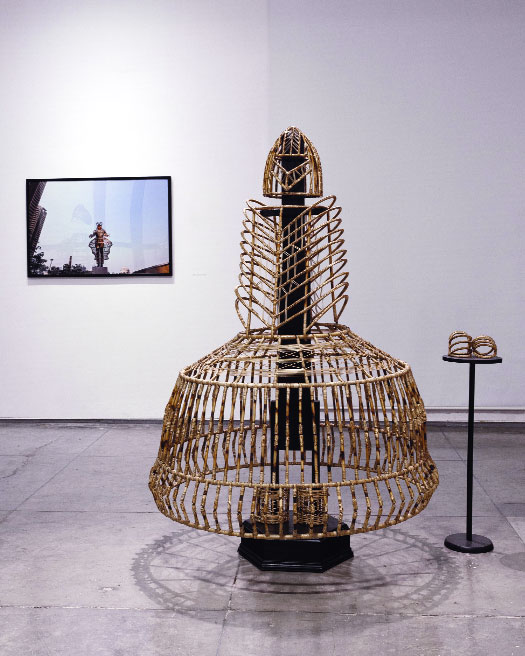Shakuntala Kulkarni’s avant garde artworks at the Venice Biennale compel onlookers to ask questions, says U Nair
Most people associate the Venice Art Biennale with the national pavilions in the Giardini (Biennale gardens) or the main site at the Arsenale — the former dockyards. At the India Pavilion at the former, visitors are swirling around the cane cages of the brilliant artist Shakuntala Kulkarni, and for once the language of the selfie is inclusive of avant garde contemporary Indian art. Utterly feminine, tall bamboo cane ensembles are catching the interest of the visitors for their quaintness.
These artworks belong to her project Of bodies, armour and cages (2013-2018) in which historical objects like the armour and the elaborately designed costumes/dresses of different communities are brought together in the contemporary context by re-articulating the usage and the medium. In collapsing and metamorphosing the two, she blurs cultural and visual boundaries.
Caged bird
When you look at the long-skirted cages and bodies, you can’t help but think of Paul Dunbar’s famous poem, I Know Why the Caged Bird Sings. In an interview to me in 2013 she said: “For long, I have been making inquiries into body violence, atrocities and experiences of women in different spaces. The impact of these atrocities against women are uncertainty and loss of freedom and power. Women are often blamed for crimes that happen against them; the men are set free and walk around with their heads held high. Morality or norms make a woman lose power.”
But she was cautious to state that she didn’t want to show women as weak beings. “I never show women as victims,” she said emphatically. “They are victimised. They are not completely weak. I show how they fight it out, how they deal with it. My question is simple: This is how society is. How do I, as a woman, live powerfully?”
Linear and delicate cane
Shakuntala’s sculptures have an Indian insignia. “ I used the armour as a metaphor to explore how I could protect my body,” states Shakuntala. “I borrowed from all kinds of cultures; Naga masks, Rajasthani ghagras, hair styles from Bollywood in the 1960s — my pieces have no cultural, geographical or religious boundaries. I used cane because I am comfortable with it; also, it is linear, delicate and looks grand. There are rings, bangles, flared skirts and it is very feminine.”
As you look through the cane — the ideation seems full of multiple perspectives.The cane is tenuous and tensile, flexible yet delicate in a strong sort of way. No doubt there are many references — history culture and the beauty of dances, Kathakali and Manipuri costumes and regalia become a translation — that are royal yet replete with rhythmic intonations.
Between dualities
Her thought process is fascinating, “I wanted to explore what happens when you have a costume as protection… There’s a freedom you experience when you’re in armour, but at the same time, some part of your body is caught. You’re trapped but you’re also secure. That to me is interesting.”
Visitors at Venice are fascinated by the very structure and the grandeur of the armour which is masculine, stiff, strong, lasting and peerless in nature. The cane figures and heads provoke us to ask questions. The cane armour /costumes in this project speak of the grandeur too. But the elaborately structured dresses look relatively feminine, linear, fragile, and organic in nature, protecting the body, breaking the gaze by the joineries of the pieces of cane and the weave. In more ways than one these cane installations are reflective of ‘interesting times’ in the words of curator Ralph Rugoff. These sculptures were part of her solo show at Chemould Gallery, Mumbai last year.
Writer: U Nair
Courtesy: The Pioneer








 OpinionExpress.In
OpinionExpress.In















Comments (0)